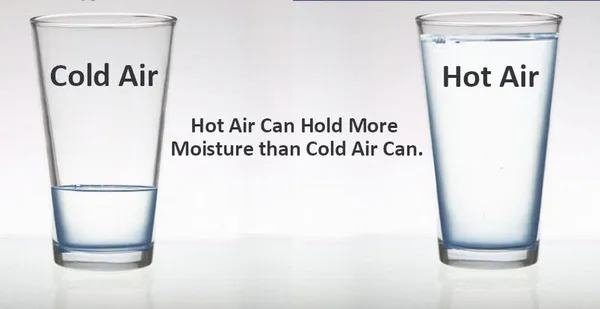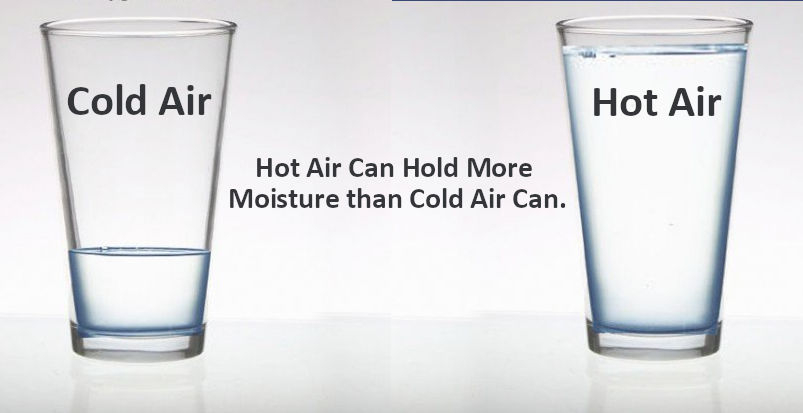
Sweaty Vents = Condensation = 100% relativity humidity.
Condensation only occurs when there is 100% relative humidity. To avoid condensation, buy a sensor that detects relative humidity and don’t let it get above 100%.
The picture above and below shows that for the same volume of air, hot air will hold more water than cold air.
A more accurate representation than the picture below would be a video showing only one glass that grows bigger when the temperature increases, and smaller when the air gets colder.
Look at the “Hot Air” glass. As the glass shrinks (as air gets colder) , water will spill. When air can no longer hold the amount of water it has, because of colder temperatures, it “spills out” and you will see condensation.

Condensation creates moisture for mold to grow in your vents, and the forced air in your HVAC system then carries that mold throughout your location.
Condensation is caused by just three things…
Prevent or reduce the likelihood of these happening in your home or workplace and you will significantly reduce the likelihood of mold growth.
Things that can increase the likelihood of these taking place are…
You can a watch a more in-depth explanation about condensation and relative humidity here.
It is summer. In Florida. The humidity gets so high you almost need gills to breathe outside. As the humidity level rises outdoors, condensation may gradually begin to appear on the surface of your air conditioning ducts. The greater the temperature difference between the inside air and the ‘conditioned’ air, the greater the chance that the ductwork could begin to develop condensation. It is a natural process and much like the way a chilled beverage reacts when it meets warmer temperatures.
Ductwork condensation can also be caused by the following:
In some cases, duct condensation can be a sign of a duct leaking air, which reduces your air conditioning unit’s efficiency. If you own an older home or your ductwork is not properly maintained, ductwork sweating is more likely to become an issue as both the temperature and humidity levels rise.
Also, advances in housing insulation have meant a big increase in condensation problems. Homeowners should be incredibly careful to prevent the dampness from causing other problems. Unfortunately, the better your home is insulated, the more chance you have of developing condensation and dampness.
When people used to regularly open chimneys and windows, houses were readily ventilated. Now double glazing, central heating, and blocked up fireplaces (particularly in older homes) mean that fresh air rarely circulates around your home. This creates good conditions for condensation and potentially mold. If you do not know, the cost of mold cleaning can run in the thousands of dollars.
Specific to air conditioner vents, water could be created from an air leak in the vent, or something called the duct boot. The duct boot is a piece that connected the vent to the duct. It needs to be properly sealed so cold air will not escape. When cold air mixes with humid air, that is when the condensation and moisture occurs.
Mastic sealant can help solve this problem but speak with a professional first. Additionally, if you have not sealed all the seams and connections in your ductwork, it is highly recommended that you do so. Not only will this help prevent condensation, but you will also experience great energy savings and a better indoor environment.
If you have air conditioner ducts made of sheet metal with no insulation, or ducts with damaged insulation, you are much more likely to develop condensation inside the ducts and / or condensation on the air conditioner vents. Sometimes the problem is compounded by a lack of ventilation in attics, crawl spaces, or closets where air conditioner ducts are sometimes placed.
Additionally, condensation is not the only cause of moisture in your ducts or dripping from your vents. The water might be coming from your air conditioning system. This is probably what you were worried about when you first noticed any moisture.
Condensation is made of liquified water vapor. It is a byproduct of your air conditioning system. Your air conditioner removes moisture from the air and drains away through a tube called a drain line, normally emptying into a drain pan.
There are a couple of problems that can go wrong with your drain system. The drain line could get clogged, causing water to leak out. The drain pan could get clogged, causing it to overflow. Either of these things could cause water to end up in your duct, and eventually drop out through your air conditioner vent.
A frozen evaporator coil is another possible cause of water coming from your air conditioner vent. In this case, you will probably also notice that the system is not cooling well and there is little air coming from your vents. If you turned off your system to investigate and then noticed the water, a frozen coil could be your problem. The ice on the coil can begin to melt, dripping through the ducts and your air conditioner vents.
Frozen coils are often caused by airflow problems (like a clogged filter) or possibly a refrigerant leak. For either of these, it is best to get your system checked by a professional. The strain on the system from frozen coils can lead to compressor failure, which is something you want to avoid. Also, be smart and do not try to deal with refrigerant chemicals without proper training.
So, with all this talk about excess moisture and condensation indoors, you may ask yourself what are the consequences? Too much humidity can cause wet stains on walls and ceilings, moldy interiors (potentially very harmful) musty odor, and/or a clammy feel to the air. Rot and structural damage can also result from extended periods of high humidity in your home. Dust mites will thrive when the humidity is high, and their excrement is a severe allergen that affects many, many people.
To summarize, condensation and dampness in your home and around your air conditioner vents is something you want to investigate immediately when you see it. Repairing the duct boot is an easy and inexpensive process and expert can perform for you. Replacing your air conditioner system is not inexpensive nor is it something that is fun to go through. In a typical Florida summer, you do not want to go one minute without air conditioning. Imagine having to go for several days waiting for your system to be replaced. Keep your home happy and it will keep you happy for years to come.
